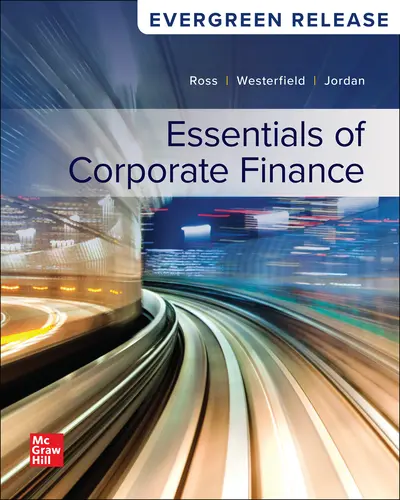My Account Details

ISBN10: 126592015X | ISBN13: 9781265920159

* The estimated amount of time this product will be on the market is based on a number of factors, including faculty input to instructional design and the prior revision cycle and updates to academic research-which typically results in a revision cycle ranging from every two to four years for this product. Pricing subject to change at any time.
Instructor Information
Quick Actions (Only for Validated Instructor Accounts):
Essentials of Corporate Finance by Ross, Westerfield, and Jordan provides a streamlined introduction to the core concepts of corporate finance, focusing on what students from diverse backgrounds need to know. Written in a relaxed, conversational style, the text invites active learning and emphasizes three key themes: intuition, a unified valuation approach, and a managerial focus. Complex financial principles are explained at an intuitive level, with net present value (NPV) as the foundation of corporate finance. By focusing on the role of the financial manager as a decision-maker, the book prepares students to apply these concepts in real-world scenarios.
Chapter 1: Introduction to Financial Management
PART TWO: UNDERSTANDING FINANCIAL STATEMENTS AND CASH FLOW
Chapter 2: Financial Statements, Taxes, and Cash Flow
Chapter 3: Working with Financial Statements
PART THREE: VALUATION OF FUTURE CASH FLOWS
Chapter 4: Introduction to Valuation: The Time Value of Money
Chapter 5: Discounted Cash Flow Valuation
PART FOUR: VALUING STOCKS AND BONDS
Chapter 6: Interest Rates and Bond Valuation
Chapter 7: Equity Markets and Stock Valuation
PART FIVE: CAPITAL BUDGETING
Chapter 8: Net Present Value and Other Investment Criteria
Chapter 9: Making Capital Investment Decisions
PART SIX: RISK AND RETURN
Chapter 10: Some Lessons from Capital Market History
Chapter 11: Risk and Return
PART SEVEN: LONG-TERM FINANCING
Chapter 12: Cost of Capital
Chapter 13: Leverage and Capital Structure
Chapter 14: Dividends and Dividend Policy
Chapter 15: Raising Capital
PART EIGHT: SHORT-TERM FINANCIAL MANAGEMENT
Chapter 16: Short-Term Financial Planning
Chapter 17: Working Capital Management
PART NINE: TOPICS IN BUSINESS FINANCE
Chapter 18: International Aspects of Financial Management
APPENDICES
Appendix A: Mathematical Tables
Appendix B: Key Equations
Appendix C: Answers to Selected End-of-Chapter Problems
Appendix D: Using the HP-10B and TI BA II Plus Financial Calculators
Need support? We're here to help - Get real-world support and resources every step of the way.
